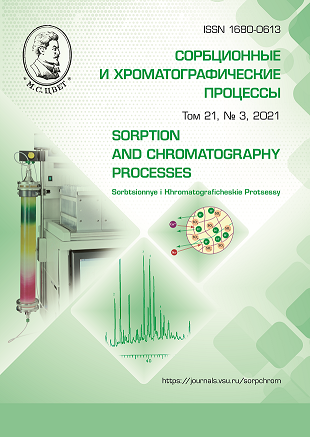Investigation of the sorption of ammonia from a gas-air medium bymodified ion exchange fibres
Abstract
Purification of process gases from ammonia is an urgent problem in the chemical industry. The aim of the research was investigation of the sorption of ammonia from a gas-air medium by modified fibrous sorbents. Carboxyl fibre VION KN-1 in copper, nickel and zinc forms was used as an ammonia sorbent. The study of the absorption of ammonia was carried out on air-dry and moisture-saturated samples of the fibrous sorbent. For the study of sorption in desiccators, atmospheres with a volume concentration of ammonia from 10 to 300 mg/m3 were created. The maximum permissible concentration of ammonia in the air of the working area was 20 mg/m3. After sorption of ammonia, the modified fibrous sorbents acquired colours characteristic of amino complexes. The fibre with absorbed ammonia was treated with a solution of hydrochloric acid with a concentration of 0.1 mol/dm3 under static conditions at a temperature of 293 K for 90 minutes. The concentration of ammonium ions was determined using I-130 ion meter with an ion-selective electrode. The photometric method was used to determine the concentration of metal ions in solutions after desorption. It was established that the copper form absorbs the greatest amount of ammonia. At low gas pressures, a sharp absorption of ammonia by the modified fibre was observed. Unmodified fibre has a lower sorption capacity, which was explained by the different mechanism of sorption of ammonia molecules on the protonated and ionic forms of the fibrous sorbent. The Langmuir and Freundlich equations were used for quantitatively description of the equilibrium process of ammonia sorption by modified fibres. The correlation coefficients for the Langmuir equation were close to one. At high pressures, the sorbent was completely saturated and the increase in pressure no longer affected the gas absorption. The obtained results on the sorption of ammonia are consistent with quantum-mechanical calculations in the Hyper Chem software module on the formation of complexes containing from 1 to 3 ammonia molecules on a carboxyl fibre containing both copper and nickel. Kinetic dependences of ammonia sorption on samples of copper and nickel forms of VION KN-1 fibre were obtained with an ammonia concentration in the gas phase of 10 mg/m3.
It has been shown that the copper form of the fibre sorbent is characterized by a higher sorption rate. Saturation of modified carboxylic fibres with water vapour impaired their sorption properties by 8-10%.
Downloads
References
Gorshunova V.P., Spiridonov B.A., Fe-djanin V.I., Proceedings of the Voronezh State University of Engineering Technolo-gies, 2009, Vol. 5, No 12, pp. 59-61.
Vorob'evA.Ju., Spiridonov B.A., Gorshunova V.P., Nebol'sin V.A. et al., Pro-ceedings of the Voronezh State University of Engineering Technologies, 2012, Vol. 8, No 7-2, pp. 4-7.
Gorshunova V.P., Haustova M.M., Vestnik VSTU, 2010, Vol. 6, No 11, pp. 19-21.
Gorshunova V.P., Nebol'sin V.A., Lukin A.N., Modern problems of science and edu-cation, 2012, No 3, pp. 424-432.
Vasiliev L.L., Kulakov A.G., Mishkinis D.A., Safonova A.M. et al. «Activated Car-bon For Gas Adsorption», in 3d Int. Sympo-sium on Fullerene and Semifullerene Struc-tures in the Condensed Media, 22-25 June, Minsk, Belarus, 2004, pp. 110-115.
Vasiliev L.L., Kanonchik L.E., Kulakov A.G., Mishkinis D.A. et al., International Journal of Low Carbon Technologies, 2006, Vol. 1(2), pp. 95-111.
Ksandrov N.V., Ozhogina O.R., Izvestija vuzov. Himija i himicheskaja tehnologija, 2018, Vol. 61, No 8, https://doi.org/10.6060/ivkkt201861008.5726
Sharonov V.E., Veselovskaya J.V., Aris-tovYu.I., Int. J. Low Carbon Tech., 2006, Vol. L, No 3, pp. 191-200.https://doi.org/10.1093/ijlct/1.3.191
Aristov Ju.I., Gordeeva L.G., Kinetika I kataliz, 2009, Vol. 50, No 1, pp. 72-79.
https://doi.org/10.1134/S0023158409010091
Veselovskaya J.V., Tokarev M.M., Aristov Yu.I., Appl. Therm. Eng., 2010, Vol. 30, No 6-7, pp. 715-723. https://doi.org/10.1016/j.aplthermaleng.2009.11.001
Tokarev M.M., Veselovskaya J.V., Yanagi H., Aristov Yu.I., Appl. Therm. Eng., 2010, Vol. 30, No 8-9, pp. 845-849. https://doi.org/10.1016/j.applthermaleng.2009.12.016
Polikarpov A.P., Shunkevich A.A., Grachek V.I., Medjak G.V., Russian Chemi-cal Journal, 2015, Vol. 59, No 3, pp. 102-111.
Kosandrovich E.G., Doroshkevich O.N., Bulletin of the National Academy of Sciences of Belarus, 2014, No 1, pp. 91-95.
Astapov A.V., Peregudov Y.S., Popova K.A., Kopylova V.D., Russian Journal of Physical Chemistry A, 2010, Vol. 84, No 3, pp. 491-494.
Lidin R.A, Andreeva L.L., Molochko V.A. Konstanty neorganicheskih veshhestv: spravochnik, M., Drofa, 2006, 685 p.
Sokolovskij A.E., Radion E.V. Fiziko-himicheskiemetodyanaliza, Minsk, BGTU, 2007, 118 p.
Niftaliev S.I., Astapov A.V., Peregudov Ju.S, Bakaeva Ju.V., Kondensirovannye sredy i mezhfaznye granicy, 2012, Vol. 14, No 2, pp. 221-223.
Romanovskij B.V. Osnovy himicheskoj kinetiki. M., Jekzamen, 2006, 415 pp.







